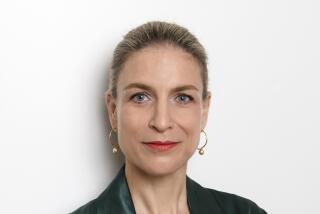Suit Alleges Secret Affair by Hammer : Courts: The niece of the late industrialist’s wife, in a bid to acquire his art collection, accuses him of longtime infidelity with the chief fund-raiser of his Westwood museum.
The late industrialist Armand Hammer engaged in a longtime extramarital affair with the woman who is now chief fund-raiser at the Westwood museum that bears his name, according to newly filed documents in a bitter lawsuit over legal title to Hammer’s art collection.
In 1974, the court documents state, Hammer even had the woman named curator of art of Occidental Petroleum Corp., which Hammer headed from 1957 until his death at the age of 92 last Dec. 10, even though the oil company at the time allegedly had no art holdings.
The allegations of longtime infidelity by the legendary Hammer are contained in court filings made on behalf of Joan Weiss, the niece of Hammer’s wife, Frances. Frances Hammer died in December, 1989. The Hammers were married in 1956.
In the litigation, Weiss seeks to gain half ownership of Armand Hammer’s art collection. She contends that Frances Hammer was improperly induced by Armand Hammer, Occidental and various lawyers to sign away her interest in the paintings, drawings and sculptures.
The allegations of a sexual relationship involve Hammer and Hilary Gibson, now chief financial officer at the Armand Hammer Museum of Art and Cultural Center. When the alleged affair began in the early 1970s, Gibson was known by another name, Martha Wade Kaufman.
The Weiss documents allege that the legal name change “reflected the desire of both Martha Kaufman and Armand Hammer . . . to conceal from Frances Hammer (the fact) that he had selected Martha Kaufman to hold a high-ranking position at the Armand Hammer museum.”
Amy West, a spokeswoman for the Hammer museum, said Gibson would have no comment on the charges. Frank Ashley, an Occidental Petroleum spokesman, said the company had no comment except that Gibson is not currently on the Occidental payroll.
Stephen Garrett, the museum director, said in an interview Friday that the museum “had no reaction except sorrow” over the emergence of the sexual allegations. “I’m very sad that (the alleged details of the affair) should be there” in the court document, Garrett said. “Sad for the museum, primarily, but for Hilary too.”
The court filing--made late Wednesday by attorneys for Weiss--alleges that the relationship between Armand Hammer and Gibson haunted Frances Hammer in the final years of her life. Other legal documents obtained by The Times and interviews with people familiar with the situation indicate that Frances Hammer even considered separating from her husband.
“Beginning sometime before 1988, Frances Hammer became tormented by the information she received about what she believed to be a sexual relationship between Armand Hammer and Martha Kaufman,” the Wednesday court filing stated. “Frances Hammer’s torment . . . was a substantial factor in her decision to execute a new will in 1988.”
The allegations are the latest development in the often bitter, troubled and confused history of the Hammer museum, which opened in late November after Occidental Petroleum agreed to a court order limiting its investment in the facility, constructed entirely with Occidental funds.
The documents also state that Armand Hammer gave Gibson/Kaufman “substantial gifts of money and other things of value” and arranged for her employment by either Occidental Petroleum or the Hammer foundation.
In court filings opposing the Weiss claims, Occidental and attorneys for Hammer and later his estate have accused Weiss and her husband, Robert--who serves as executor of Frances Hammer’s estate--of bad faith and improper interference in Frances Hammer’s affairs.
In the early years of their relationship, Armand Hammer relied on his wife for loans and other financial support to establish himself in business, other court filings have shown.
In her lawsuit, Weiss contends that Hammer, Occidental and lawyers handling the affairs of the oil company, the Hammer family and the Armand Hammer Foundation, deceived Frances Hammer and caused her to inappropriately sign over her alleged community property rights to a half interest in Hammer’s art collection.
The collection, valued at up to $450 million, makes up the entire holdings of the Hammer museum. The case is in its preliminary stages and no date has been set for a trial or a thorough hearing on evidence in the case.
Separate financial records for the Armand Hammer Foundation, the charity set up by Hammer to handle his philanthropic affairs, show that between 1979 and 1989, Gibson--under either the name Martha Kaufman or Hilary Gibson--was paid continuously as a consultant by the tax-exempt organization, receiving $256,500. The documents, obtained by The Times, include the foundation’s federal tax returns for the period.
Gibson has testified in unrelated litigation that she has a degree from Cal State Northridge in fine art and history. She testified that she attended USC, where she majored in education, but did not graduate, and that she has been a painter.
In earlier sworn testimony in a lawsuit by Occidental shareholders challenging the company’s expenditure of more than $90 million to build and endow the museum, Gibson confirmed one of the allegations in the new Weiss court filing. She said she was first employed by Occidental in 1974 as the company’s curator of art but that she was unaware of any art the company owned at the time.
At Occidental, sources in both the company and the museum have said, Gibson served as one of Hammer’s most trusted aides.
In the final years of her life, culminating in the will changes executed in 1988, Frances Hammer virtually cut her husband out of her estate, even stipulating that he was not to inherit the Westside home she had purchased and in which the couple lived for many years. Hammer retained rights to live in the home until his death.
“Frances Hammer’s decision to eliminate Armand Hammer and the Armand Hammer Foundation as beneficiaries . . . reflected her feelings toward Armand Hammer, the Armand Hammer Foundation and the Armand Hammer Museum of Art and Cultural Center,” the new legal documents contend.
More to Read
The biggest entertainment stories
Get our big stories about Hollywood, film, television, music, arts, culture and more right in your inbox as soon as they publish.
You may occasionally receive promotional content from the Los Angeles Times.










